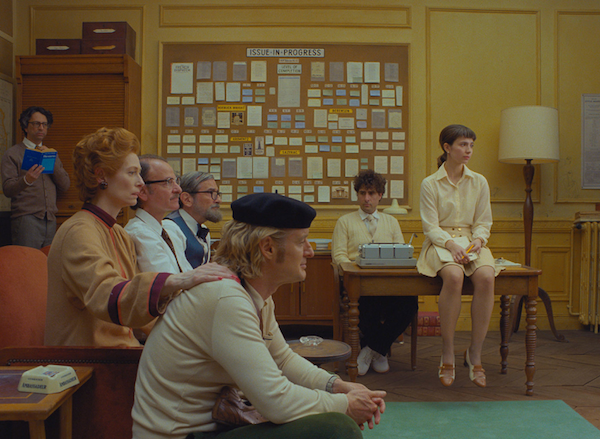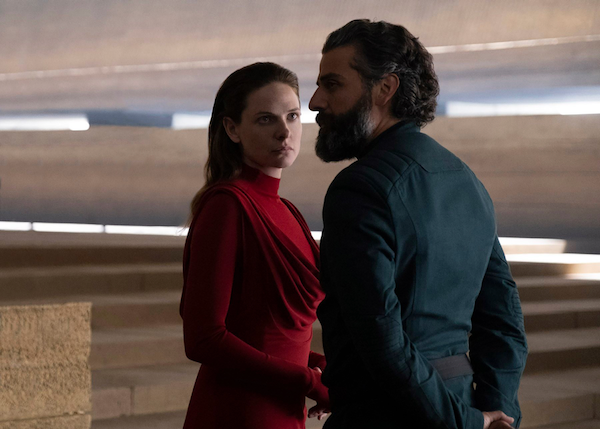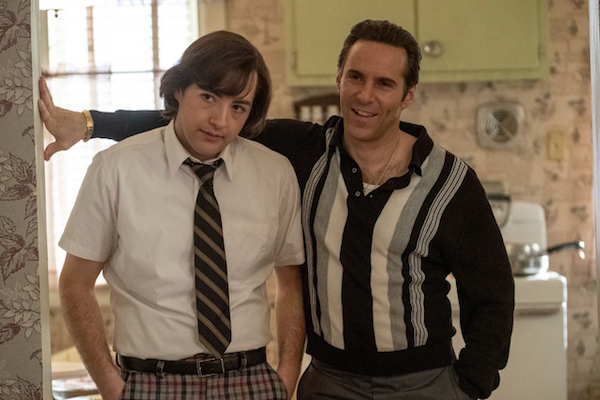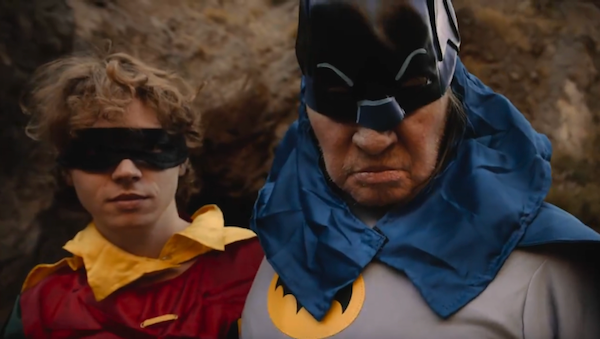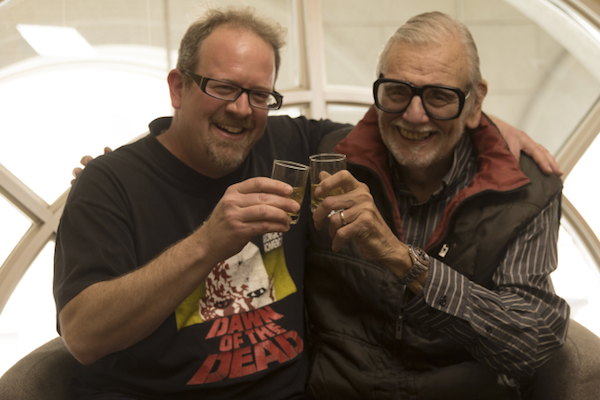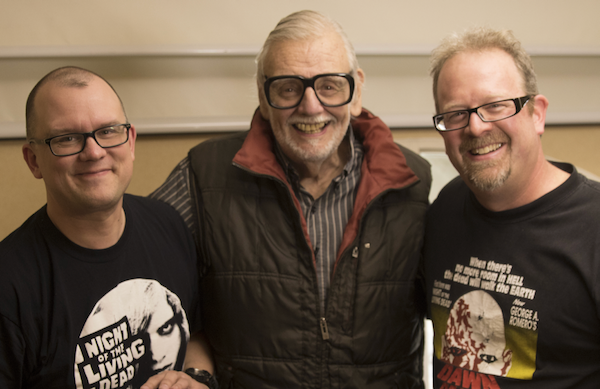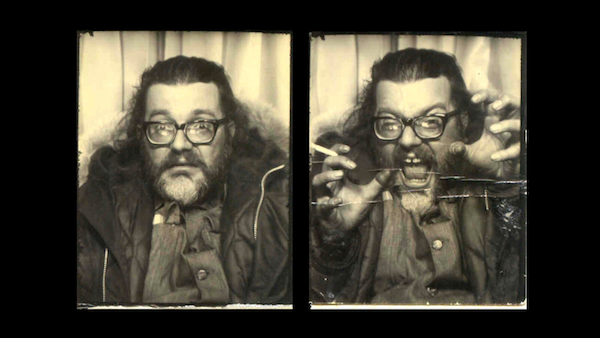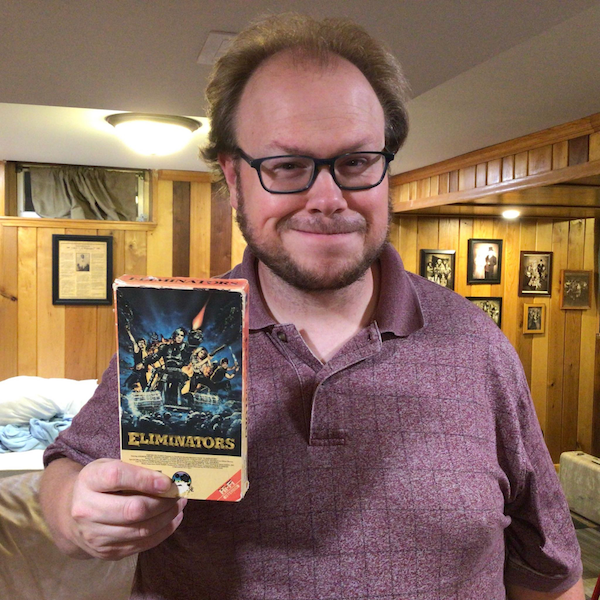
Interview by Greg Carlson
Before she introduced us, mutual friend Morgan Davy told me that Anthony Strand had the uncanny ability to remember the exact running time of every movie he had seen. And he has seen a lot of movies.
Strand was born in 1984, under the sign of “Amadeus,” “This Is Spinal Tap,” and “The Muppets Take Manhattan.” He currently lives in Roseville, Minnesota, with his wife Rosalynn and their two children. He is a school librarian in Farmington, Minnesota, where he enthusiastically hosts the morning announcements.
Greg Carlson: My mom took me to “Snow White and the Seven Dwarfs.” What was your first theatrical screening?
Anthony Strand: My first movie in the theatre was also a Disney reissue. I saw “The Jungle Book” in 1988. Twenty-one years following the film’s original release. That thing Disney used to do where it was every seven years. So I got in on the tail end of that tradition.
GC: When you go to see a movie at a very young age, some kinds of memories might stand out more than a full grasp of the film itself. Getting popcorn or the lobby of the theatre might leave as big an impression as any fear of the Evil Queen disguised as an old crone or any fascination with the Magic Mirror.
AS: My brother just gave me the VHS of “We’re Back! A Dinosaur’s Story.” It’s not a good movie, but I was 8 years old when it came out. And we watched it so many times. I hadn’t looked at it in probably 25 years and the only thing that was familiar was the big John Goodman musical number by Thomas Dolby and James Horner.
There’s a scene in the movie where a little girl wishes for a Thanksgiving hat. And I have such a distinct memory as a kid believing that a Thanksgiving hat was an actual thing.
GC: Where did you grow up?
AS: I grew up in Hatton, North Dakota. There was a local video store, the Hatton Pharmacy, that became a little general store. That place was huge for me. The owner, Sutin Sorowat, was our neighbor across the alley. He would talk to me about the movies on his shelves. Stuff I had seen and stuff I had not seen.
Sutin had the Columbia House Collector’s Edition VHS volumes of “All in the Family.” I rented every one of those tapes when I was 12 and 13. And that show became one of my favorite things to watch.
GC: So many cinephiles have that intellectual curiosity combined with a voracious appetite to consume content. And especially things that were made before you were born.
AS: I was always into old sitcoms. When I was in sixth grade, I kept a set of tabbed file folders so I could write down information like the network, the number of episodes, and what years a series aired.
GC: Where were you getting that information?
AS: Two of my most treasured items were “Total Television” by Alex McNeil and “The Complete Directory to Prime Time Network and Cable TV Shows 1946-Present” by Tim Brooks and Earle Marsh. I read both from cover to cover and of course put a star by everything that I had seen. After those two books I soon acquired an edition of Leonard Maltin’s Movie Guide.
GC: Once the Maltin book was updated and issued every year, my mentor Ted Larson would circle the street date and turn it into an event. I would often accompany him to the bookstore where he purchased three or four copies — one for the office at school, one for the projection booth in Weld Hall, one for home, etc.
Eventually, I was also buying the new edition every year and would also go through and mark the films I had seen.
AS: I think the last Maltin I picked up was 2002, when I was a senior in high school. Specifically with that one, I decided to go through it and write down a list of movies that I thought I should see. I got a little green notebook and started copying over titles. I only made it to G before I had to stop.
GC: Was your to-see list based on the star ratings?
AS: Yes, but I did take some of them with a grain of salt.
GC: How dare Maltin give “Taxi Driver” only two stars!
AS: So funny that “Taxi Driver” is the one Maltin review that always comes up. It is burned into my brain that he describes the film as “ugly and unredeeming.”
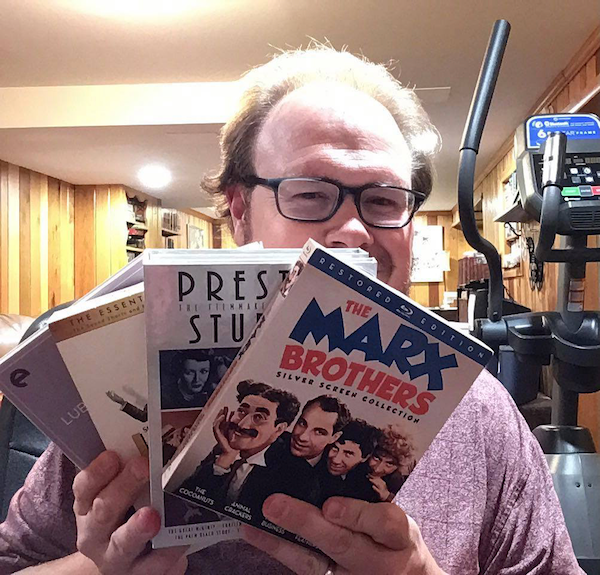
GC: Well, I still think it is a masterpiece. But you were more into comedy.
AS: The real gateway for my interest in classic movies was the Marx Brothers.
GC: How did you find your way to them?
AS: I watched the Three Stooges with my dad and my brothers every week. As a sixth grader, I wore my Three Stooges t-shirt on the first day of school. Carefully chosen. “This is who I am.” The year is 1996.
For Christmas, my grandma, perhaps misunderstanding or misremembering, got me a hardcover book about the Marx Brothers, a comedy team I had never seen and had no experience with. I thought, “I don’t know what this is, but I will look into it.” It was a slim hardcover called “Marx Brothers” by Kate Stables and I must have read it a thousand times. It has a picture from “Duck Soup” on the cover with the four brothers in their military uniforms.
I had not seen any Marx Brothers films yet but I thought, “This sounds great! I need to see this stuff.” So the “wrong” book turned out to be exactly the right book. I checked “Duck Soup” out of the Grand Forks Public Library and I loved it. It is my favorite movie to this day.
Not long after, I bought “A Night at the Opera” and “A Day at the Races” on VHS at Suncoast Motion Picture Company. What a world! A person could walk into the Columbia Mall in Grand Forks, North Dakota, and buy “Horse Feathers” and take it home. Incredible!
GC: My grandpa got me hooked on Humphrey Bogart. Our goal was to collect as many Bogart movies as we could find. As a fairly early adopter of VHS, my grandpa owned several decks and we would attempt to dub copies of movies we rented from Videoland as well as record features from broadcast and cable. I still cherish the tapes with my grandpa’s hand-written labels.
AS: I love that. I bought the first seven Marx Brothers movies, but I had “Room Service” recorded from AMC. That was the one Marx Brothers movie that I taped from TV. So my interest in the Marx Brothers was the start, but two things also happened around the same time. I got my first DVD player with my own paper route money at the age of 14. And the debut in June, 1998 of AFI’s 100 Years … 100 Movies on CBS. I decided to see all 100 of the movies on the AFI list. It took me a while, but I eventually did it. I managed to see all but one before I graduated from high school.
GC: I have to know, what was the last one?
AS: “Midnight Cowboy.” It was when I decided to watch every Best Picture winner that I saved “Midnight Cowboy” for last so I could finish both lists at the same time.
GC: No matter how many movies or TV shows you have seen, the joy of checking off titles can be satisfying.
AS: Even though I saw “The Naked Gun” first, I loved “Police Squad!” I rented those tapes from Videos Plus Pizza & Subs in Mayville, North Dakota. In one of the television books, there was a description of “Sledge Hammer!” claiming it was in the vein of “Police Squad!” I had never seen “Sledge Hammer!,” which ran for two seasons on ABC. The show was long gone by the time I was first learning about its existence. So for years, I longed to see “Sledge Hammer!”
Then the TV on DVD boom happened. I bought both seasons of “Sledge Hammer!” because I had spent all that time building it up in my mind. I kept thinking, “What if these 41 episodes are like more “Police Squad!” shows?” And it is not quite that. It is a more conventional satirical sitcom. But I enjoyed it.
GC: Will you abandon a show if it does not meet your standards?
AS: I do now, but not so much then. The older I get, the less patience I have for so-called prestige television, which doesn’t appeal to me. There are exceptions, of course. I watched all of “The Wire,” and it is brilliant.

GC: Making viewing choices can be torturous. I am always prioritizing between newly-released films and classic cinema that I have not previously viewed while still making room for key re-watches. I just saw “The Two Mrs. Carrolls” for the first time this year and I loved it.
AS: What is the Bogart movie where he discovers the cafe is a front for Nazis?
GC: “All Through the Night.”
AS: Remind me, is his best friend William Frawley?
GC: William Demarest.
AS: Right! I knew it was a grandpa or uncle from “My Three Sons.” “All Through the Night” was the last new-to-me Bogart movie that I saw and wondered why hardly anyone talks about it. With a title like “All Through the Night,” you can understand why I couldn’t remember the name of the movie.
GC: I love it when you find a semi-forgotten gem, fall in love, and then recommend it to everyone. You end up associating certain films with the friends who champion them. Every year on Ben Hanson’s birthday, I post the loop of Sam Neill saying, “The lies!” from “Possession.”
AS: And yet I associate Ben Hanson with “Legend,” because he bought my DVD copy when I decided to let it go. I know “Legend” isn’t Ben’s favorite movie, but anytime it comes up I am reminded of him.
GC: One might think Ben’s favorite movie is “Airplane!,” but I believe it is “Brazil.”
AS: Makes sense. The three-disc Criterion set of “Brazil” was one of my high school staples. The television cut with the happy ending is fascinating. Profanity edited out. You know, “Give me the keys, you fairy godmother” kind of stuff. And it’s 94 minutes long. As long as we’re talking about physical media, I appreciate the way the Criterion has an enthusiastic presentation of a cut that asks, “What if this movie was bad? Well, here it is, preserved in amber.”
GC: More television cuts should be included as bonus content. I am still drooling over Criterion’s “Fast Times at Ridgemont High,” which contains the television edit of the film. That alone makes it worth the price.
AS: “The Jerk” is another one that always comes to mind. Steve Martin’s dog is named Shithead, but in the TV version the dog is called Stupid.

GC: As a parent of young children, what kind of content do you share with your kids?
AS: My daughter Iris is six and my son Miles is three. We watch a lot of old “Sesame Street.” Iris especially loves Looney Tunes and Merrie Melodies. Iris and I have been working on a project to view every Best Animated Short in order. We haven’t gotten to all of them and are up to 1960 or so.
What has been fun for me is to see her discover new things. She already knew Tom and Jerry. They had too many wins — seven to just one Bugs Bunny. That ratio should be flipped. But she didn’t know Mister Magoo. And she was not into it. But both my kids went bananas for the Yugoslav cartoon “Surogat,” which is known in English as “Ersatz” or “The Substitute.” Watched it three times in a row.
GC: What is the story behind your interest in “Eliminators”? I have never seen it.
AS: It’s from Charles Band’s legendary Full Moon Features. One of the great schlock VHS houses at its peak in the 1990s. They cranked out tons of direct-to-video sci-fi and horror. I am not a huge horror guy once you get past Hammer, but my brothers and I loved Full Moon’s sci-fi offerings. There’s something about them, you know?
The director of “Eliminators” is a guy named Peter Manoogian. And he made a lot of movies that are almost incompetent but compulsively watchable. We say the lines with irony, but we have also seen all these movies many times. “Eliminators.” “Arena.” “Seedpeople.”
In “Eliminators,” a scientist builds this cyborg named John T. Mandroid. Mandroid seeks revenge for the death of his father — that’s the premise. And the thing takes place in a generic Amazon-esque jungle location. And here’s how I sum it up: When John T. Mandroid is about to set off on his mission, he turns to Denise Crosby and says, “I’ll need my mobile unit.” Smash cut to John T. Mandroid now in his mobile unit — his torso connected to a set of caterpillar treads.
When you are a kid, you might find these movies by chance at the store. Then you buy a tape and watch it a bunch of times. That’s part of what was special about physical media before Netflix. You have the item in your house and the lack of so many options means you end up playing it over and over.
GC: Tell me about your podcast.
AS: My partner Ryan Roe and I co-host “Movin’ Right Along: A Muppet Movie Podcast.” Our podcast shamelessly borrows the basic format of “Star Wars Minute.” We watch and discuss the Muppet movies two minutes at a time. We’ve been at it for a little over three years and have made it through three films: “The Muppet Movie,” “The Great Muppet Caper,” and “The Muppets Take Manhattan.” Each episode is around a half hour.
We’ve had some great guests. Brian Jay Jones, author of “Jim Henson: The Biography.” Michael Frith, former Executive Vice-President and Creative Director of The Jim Henson Company. This is the guy who designed Uncle Deadly and Fozzie, among many others.
Frith also designed the Muppet Babies for “The Muppets Take Manhattan.” He was a liaison to the later Muppet Babies cartoon. His appearance on our show was to focus specifically on the Muppet Babies.
We’ve had several Henson puppeteers on the show, including Leslie Carrara-Rudolph, who plays Abby Cadabby, and longtime performer Andy Hayward. Pop culture writers, too. Will Harris and Noel Murray and Erik Adams from “The A.V. Club.”
GC: Who is your favorite Muppet?
AS: Ernie. Always. This is a guy who has many songs exploring his own intellectual curiosity about the world. “I Don’t Want to Live on the Moon.” “I Wonder.” “Imagine That.” Ernie’s inner life is thoughtful and introspective. But Ernie’s outer life sees him playing savage tricks on his roommate, like stealing his nose. I can relate to that.
GC: Well, I’m a total Bert. I was able to recognize that even when I was watching “Sesame Street” in the 1970s. I grew up and married an Ernie. So far, it has worked out.
AS: Great! Can I say one more thing?
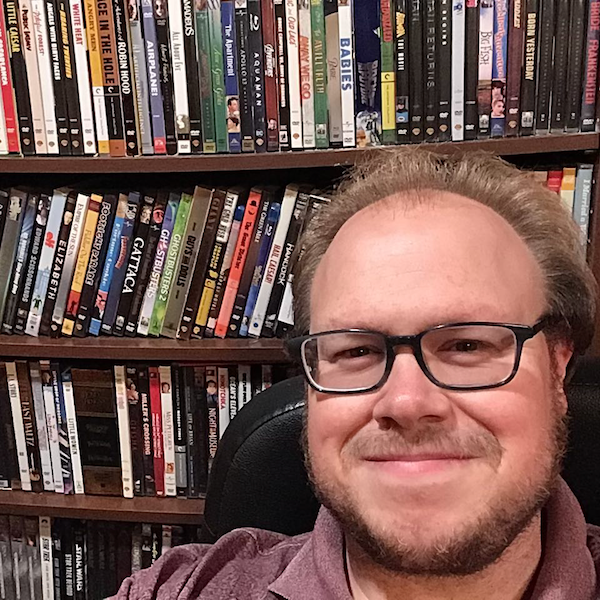
GC: Please.
AS: During the height of DVDs, I would go out and buy any movie I saw and liked. Especially because so many of the DVDs had fantastic bonus features. I think about that a lot. I have so much nostalgia for the days when you could walk into Best Buy — which today mostly sells Bluetooth speakers and refrigerators — and find the Warner Bros. Pictures Gangsters Collection Vol. 1. It contained six movies: “The Petrified Forest,” “The Public Enemy,” “Little Caesar,” “Angels with Dirty Faces,” “The Roaring Twenties” and “White Heat.” Zero clunkers in the set. And all of them had audio commentaries, documentaries, Maltin introductions, cartoons from the feature’s release year, live action short subjects, trailers, and newsreels.
Well, I didn’t know then how good I had it.
